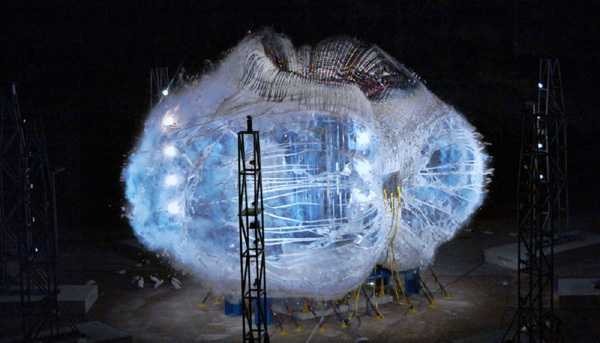
Sierra Space
Sierra Space Advances its Revolutionary Commercial Space Station Technology (Press Release)
Company is Accelerating the Introduction of Commercial Microgravity Research and Production Facilities in Space to Benefit Life on Earth
LOUISVILLE, Colo. – Sierra Space, a leading commercial space company building the first end-to-end business and technology platform in space, has achieved a groundbreaking milestone by successfully designing, manufacturing, assembling and testing its first full-scale, expandable space station structure, alongside exclusive softgoods technology partner ILC Dover.
By the Numbers:
-- Company’s first stress test of a full-size, inflatable space station structure
-- Test unit stood over 20’ tall and was comparable in size to an average family home
-- The article was 300 m³ in volume, or 1/3rd the volume of the International Space Station
-- Test results exceeded NASA’s recommended x4 safety levels by 27%
The pressure shell for Sierra Space’s LIFE™ (Large Integrated Flexible Environment) habitat is made of expandable “softgoods,” or woven fabrics that perform like a rigid structure once inflated. During an Ultimate Burst Pressure (UBP) test, the teams inflate the test article until it fails, which helps determine how strong its softgoods materials would be under extreme stresses in the harsh environment of space.
The full-scale unit in this test reached 77 psi before it burst, which well exceeds (+27%) NASA’s recommended level of 60.8 psi (maximum operating pressure of 15.2 psi multiplied by a safety factor of four).
The achievement underscores Sierra Space’s commitment to advancing the cutting-edge design and development of commercial space stations and positions the company well ahead of its global competitors. The company’s expandable technology provides for on-orbit infrastructure volume greater than 5x the fairing volume used to transport the system to orbit.
Sierra Space’s LIFE is packed inside a standard five-meter rocket fairing and inflates to the size of a three-story apartment building on orbit. In just three launches, the modular LIFE units can create a living and working environment in space that is larger, volume-wise than the entire International Space Station (ISS).
In coming years, the company will iterate on larger designs. A 1400-cubic-meter version, packaged inside a seven-meter rocket fairing, for example, would surpass the size of the ISS in a single launch.
Building upon this successful test, Sierra Space will embark on an aggressive 2024 testing campaign at both sub- and full-scale, including a series of UBP tests in tandem with early-stage development of the primary Atmospheric Barrier and Micrometeoroid Orbital Debris (MMOD) layers.
The test specifically focused on the LIFE habitat pressure shell – otherwise known as the restraint layer – which is comprised of Vectran straps along with a series of other high-strength fabric materials. Sierra Space, working with its exclusive softgoods technology partner ILC Dover, has specifically designed and tested Vectran straps at the component and sub-scale levels prior to this full-scale test.
Vectran is stronger than steel when inflated on-orbit and provides high margins of safety under pressure.
This recent full-scale UBP test was performed with support from NASA via a Reimbursable Space Act Agreement in which NASA’s Marshall Space Flight Center provides services to Sierra Space in support of its exploration and commercial Low-Earth Orbit technology development and risk reduction activities.
This test occurred in Huntsville, Ala., on Redstone Arsenal adjacent to the historic Saturn 1/1B test stand.
Source: Sierra Space
****

No comments:
Post a Comment